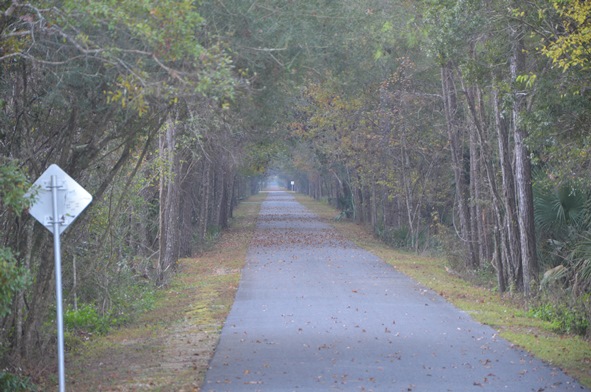
by Les Harrison | Dec 8, 2017

A great walk or ride is close at hand on this trail which once supported a critical 19th century transportation link.
The typical image of a state park is that of a place where visitors enter through a front gate and enjoy the wonders of nature or some historic structure. The Tallahassee-St. Marks Historic Railroad State Trail, which is run by The Florida Division of Recreation and Parks, is truly an exception to the typical model.
While many parks have trails, this one runs 20.5 miles from Tallahassee to the coastal community of St. Marks. This area is the first rail-trail in the Florida’s system of greenways and trails to be paved providing a scenic experience for running, walking, bicycling and skating.
Additionally, horseback riding occurs on the adjacent unpaved trail. Because of its outstanding qualities, this state trail has been selected as a National Recreation Trail.
The origins of this 21st century recreational site date back to before Florida was a state. The Tallahassee Railroad Company was approved in 1835 by the territorial legislative council and received the first federal land grant to a railroad for construction of the line.
Cotton and other commodities moved from the Tallahassee region to the port of St. Marks for shipment to the north east U.S. and to Great Brittan. Raw cotton was the major generator of foreign exchange during the antebellum years, so this railroad was a critical economic link in the area’s development.
Fast forward to 1983, that is when the Seaboard Coastline filed the papers to abandon the line and end service. After 147 years, the longest-operating railroad in Florida was deemed economically unfeasible to operate.
It was not out of service for long. In 1984 the corridor was purchased by the Florida Department of Transportation, and the rest is history.
Visitors can access the trail in multiple locations along the way. Parking areas are provided at many locations along the trail with mileage markers make available distance information and the trail corridor is lined with trees providing plenty of shade.
Restroom facilities are placed at intervals along the trail. There are picnic pavilions and a playground at the Wakulla Station Trailhead.
The trail is open from 8:00 a.m. until sundown, 365 days a year and there is no use fee required. Donations which aid with the promotion and upkeep are accepted.
For more information on the St. Marks Trail, contact the park office at (850) 487-7989 or Tallahassee-St. Marks Historic Railroad State Trail.
While the historic structures are gone, it is a great way to enjoy nature’s wonders close to the coast.
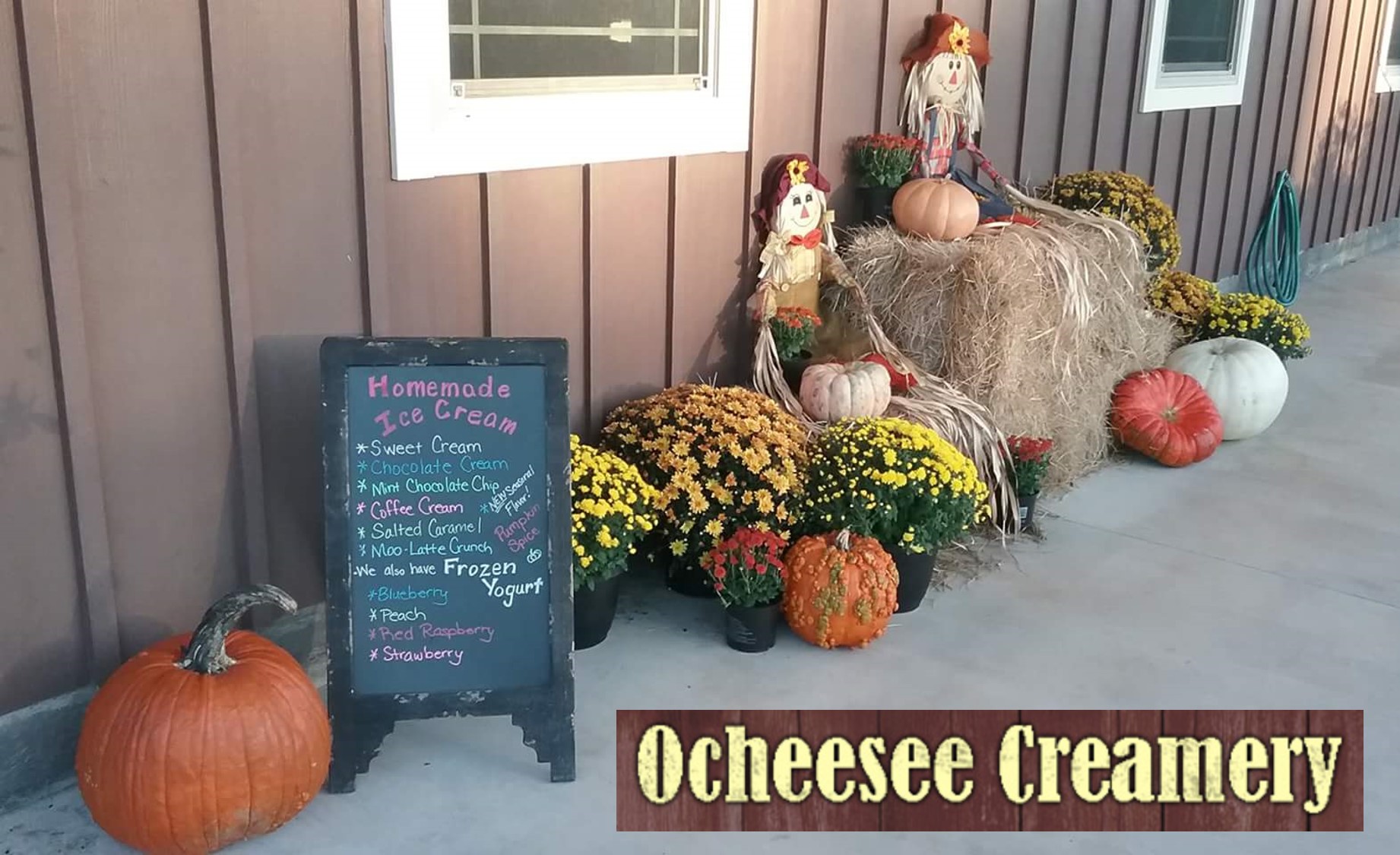
by Judy Biss | Nov 20, 2017

The Ocheesee Creamery in Calhoun County Florida participates in the annual regional Farm Tour highlighting a number of agritourism opportunities in North Florida. Photo Credit: Ocheesee Creamery
It seems each weekend this time of year is packed with things to do outside; and for good reason! The weather is perfect and the holidays are approaching. Among the many festivals and festivities are a number of farm tours, or “agritourism” related events. For example, there was the recent Tallahassee and surrounding area “10th Annual Farm Tour: “Farms, Gardens and Ranches,” and Jackson County just hosted the annual “Antique Tractor Drive” as part of its Farm City Festival.
The Merriam Webster definition of “Agritourism” is “the practice of touring agricultural areas to see farms and often to participate in farm activities.” More specifically, pursuant to Florida Statute 570.961 the definition of agritourism in Florida is “any agricultural related activity consistent with a bona fide farm or ranch or in a working forest which allows members of the general public to view or enjoy activities related to farming, ranching, historical, cultural or harvest-your-own attractions for recreational, entertainment or educational purposes.”
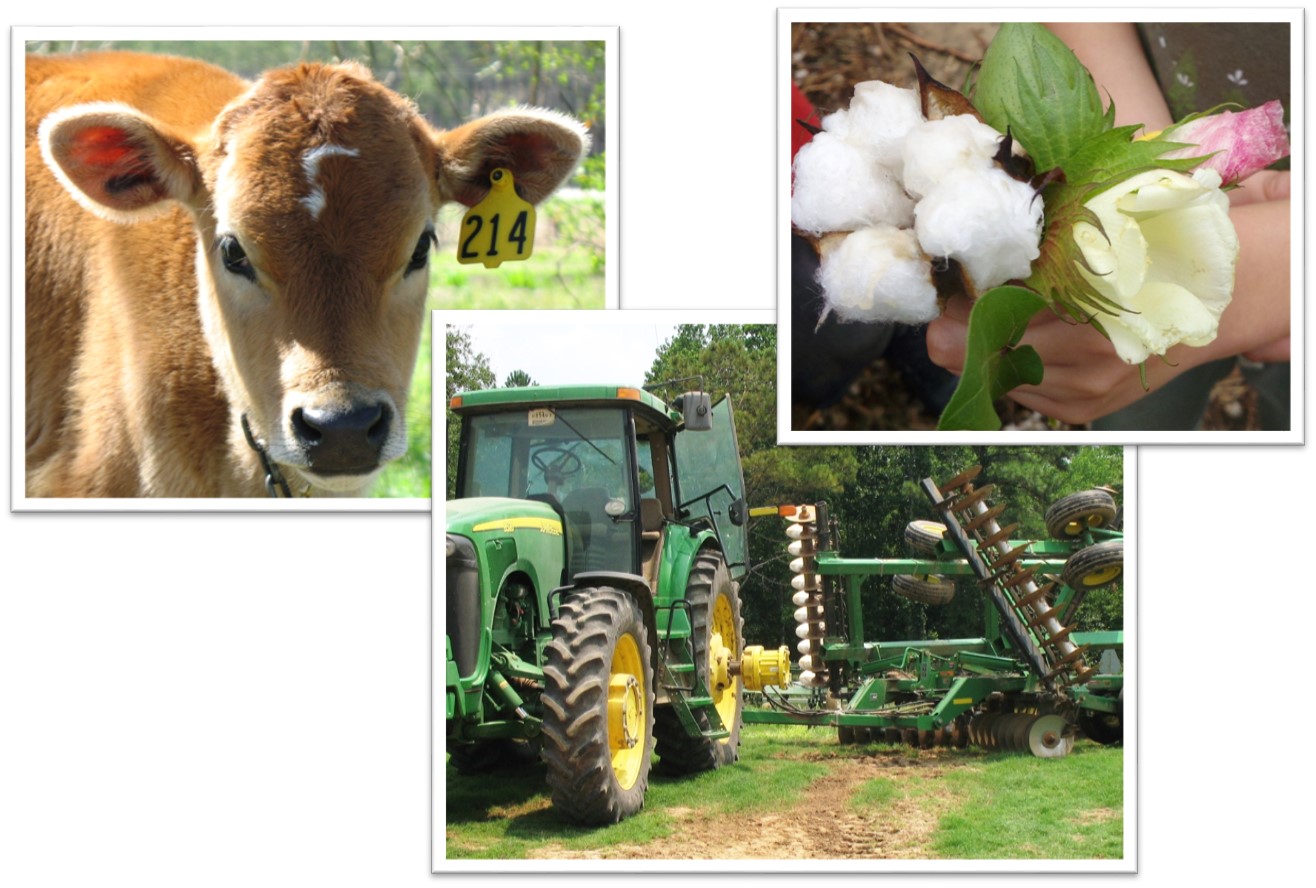
North Florida is home to a rich agricultural industry. Photo Credit Judy Biss
Panhandle Florida is an agriculturally diverse region growing everything from row crops like cotton, corn, soybeans, and peanuts to hay, timber, beef cattle, dairy cattle, fruit, vegetables, and even shellfish along the coast. Many farms are beginning to offer agritourism related opportunities as a means to increase income, but also to increase awareness of the importance of agriculture, in its many diverse ways, to our lives.
Many farms and ranches also have large tracts of land that are left uncultivated and serve as natural areas for surrounding fish and wildlife. Because of this, many farms are not only prime candidates for agritourism, but “ecotourism” as well. In addition to our numerous national forests and state parks many private landowners also have the potential to market their natural areas through ecotourism. This, also, is a relatively new industry in Florida, and more can be read about it here: Ecotourism
“Growing agritourism in Florida is a terrific way of marrying two of our oldest industries: tourism and agriculture,” said Commissioner of Agriculture Adam H. Putnam. “The growth and success of agritourism in Florida is not only good for our economy, it also celebrates the people, families and businesses that make up Florida agriculture.” (Jul 27, 2016, Commissioner Adam Putnam and VISIT FLORIDA Promote Florida Agritourism, Press release)
For more information on this topic, please see the following UF/IFAS Publications and related websites.

by Erik Lovestrand | Aug 25, 2017
Many species of animals go through dramatic swings in population numbers over time. For some, these fluctuations are related to the dynamics of a natural symbiotic connection such as a predator-prey relationship. A classic example of this is the famous snowshoe hare/lynx model taught to all wildlife ecology students. The lynx numbers follow the hare numbers with a lag in the population upswings and downswings. For other species, it may simply be related to changing environmental conditions that they either do not tolerate well or that they thrive in. This is primarily the case with our panhandle bay scallop populations from year to year. During the time I’ve lived in North Florida I’ve experienced both ends of the spectrum during local scallop seasons. Some years, you can limit-out as fast as you can pluck them from the sea grass bed. Other times, the old adage of “finding a needle in a haystack” comes to mind. Over the past few years we have experienced some of these dramatic swings for various reasons.
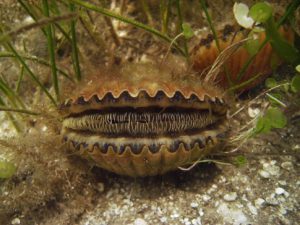
Bay Scallop Argopecten iradians
Bay scallops are mostly an annual species, with spawning taking place as water temperatures drop quickly during fall cold fronts. Harvest numbers the following summer are a result of larvae that matured in a single season. Occasionally, you will find an old “mossy-back” that is significantly larger and likely a holdover from the previous season. During spawning, a single scallop can release millions of eggs but very few survive to adulthood and throughout their brief lifespan they are susceptible to many mortality factors.
Predation by crabs, sea stars and several species of marine snails takes a toll but is generally not the driving force in significant declines.
One factor that does have population-level impacts is the amount of rainfall locally. Too much freshwater will create physiological stress and kill scallops over large areas. They can also be hammered by extreme heat or cold events due to their nature of inhabiting relatively shallow coastal waters. Other population pressures may not be so obvious because they sneak up on scallops gradually rather than happening all of a sudden. Factors such as propeller scarring in seagrass beds and siltation from terrestrial runoff or human activities, can have a cumulative effect that gradually degrades the seagrass habitat where scallops live. Another factor that can cause near-extinction of local populations is the occurrence of harmful algal blooms such as red tide. The toxins produced by these marine dinoflagellates will kill fish, marine mammals and shellfish alike. This is what happened to the scallops in St. Joseph Bay during the fall of 2015 when a red tide bloom killed most of the spawning population.
A more recent event in St. Joseph Bay, that put a damper on the 2017 season, was a bloom of a different marine dinoflagellate species known as Pseudo-nitzschia. This organism can produce a toxin known as domoic acid which can cause amnesic shellfish poisoning in humans. Thankfully, it is not expected to harm the shellfish themselves and next season may be a real bumper year. That is, if everything else that can go wrong for a scallop decides to give them a bit of a break. When environmental conditions are good, it is astounding what Mother Nature will provide. Put on your snorkel gear and check it out! For information on seasons and more detailed biology visit the Fish and Wildlife Research Institute’s webpage here. For some tasty recipes check out the Fresh From Florida page here.

by Erik Lovestrand | Jun 30, 2017
Imagine yourself as an early settler, migrating with your family into the area known as La Florida, with the hope of staking a claim and building a new life. You’ve heard stories of horrendous mosquitos, fierce native peoples, deadly snakes, and giant alligators. Regardless, the promise of abundant fish and wildlife, a year-round growing climate and a chance to start anew, override any doubts you might have and you pack your wagon, hitch up your mules and head south with great anticipation.
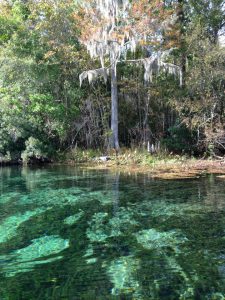
Florida’s springs are world famous. They attracted native Americans and settlers; as well as tourists and locals today.
Photo: Erik Lovestrand
Well, the mosquitos have been horrendous, one of your mules was bitten by a rattlesnake but survived, and one of your hounds was taken by an alligator at a river crossing. You are in your second month of travel and you’ve come into a strange area of forest that stretches for miles in all directions. Deep, white sands clutch at your wagon wheels and make tough going for the mules. The land is forested by tall majestic pines and the terrain is gently rolling with an open view across a landscape dominated by wiry grasses and other low growing herbaceous plants. The buzzing sound of insects in the trees makes it seem even hotter for some reason and everyone is tired and thirsty as you spy a dark line of hardwood trees just down-slope. You decide to take refuge in the shade to rest the lathered mules and hope for a water source to refill your dangerously low water cask.
As you walk back under the shady canopy you find an obvious trail that has been used by other humans for generations as evidenced by a deep rut worn into the ground between exposed limestone boulders. As luck would have it, you see the glint of water through the trees ahead. When you clear the trees near the water’s edge you stop abruptly in stunned amazement. The image of a deep blue pool of crystal clear water with a small stream exiting into the woods causes you to shake your head in disbelief. You must be dreaming, as you’ve never witnessed such a magical setting; water boiling out of a gaping hole in the earth, surrounded by white sand and long flat blades of grass waving in the current.
Just about everyone who has visited one of our sparkling North Florida springs probably has a similar, magical recollection of their first encounter. As surface water percolates downward through soil layers and the porous karst (limestone) bedrock, it is filtered and cleaned to incredible clarity. The clear water gushing forth in these artesian-spring flows remains 69-70 degrees year-round in our Panhandle springs. This is due to their open aquifer connection, from which many homes draw their drinking water directly.
However, there are some serious vulnerabilities that our springs are facing regarding the quality of the water that they provide for residents and visitors alike. One issue relates to the numerous sink holes throughout our landscape that also connect directly to this same Floridan aquifer. In the past, many of these holes have served as dumping grounds for items ranging from household garbage, to junk cars, old washing machines and refrigerators, and even the occasional murder victim. Imagine all of the pollutants that end up in our drinking water supply as a result of this. Another concern relates to pollution that goes onto the ground surface and ends up in the aquifer. This happens via runoff from paved surfaces, sediments and excess fertilizers or pesticides from the landscape, or even the intentional application of treated wastewater in spray fields located in a “spring-shed.” Water clarity and quality at many of our well-known springs has suffered from excess nutrients that cause algal growth and other unwanted, nuisance plant proliferation.
As we gain a better understanding of how water moves through our landscape and ends up flowing from these natural springs, we should become better stewards by minimizing our human impacts that degrade spring water quality. Let’s keep the magic alive for all of our future generations of nature explorers.
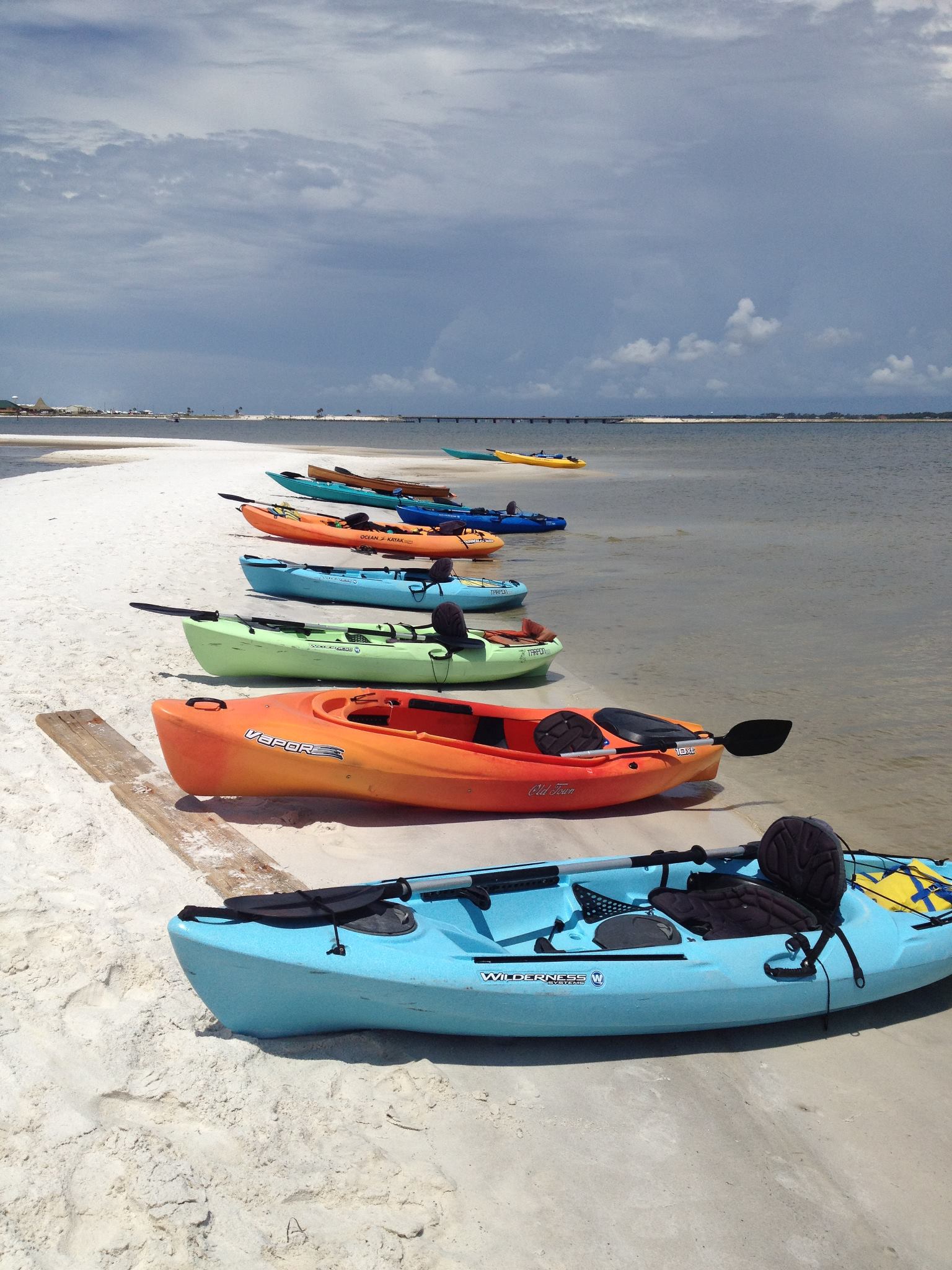
by Carrie Stevenson | Jun 17, 2017
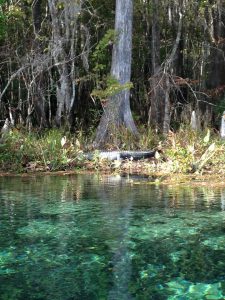
Wakulla Springs is home to some of the best wildlife watching in all of northwest Florida. It’s not unusual to see manatees, alligators, and dozens of species of birds in one boat trip. Photo credit: Carrie Stevenson
What do you imagine when the word “ecotourism” comes to mind? I know I usually daydream about a trip my husband I took to Costa Rica several years ago, surrounded by lush tropical rainforests as we ziplined through the canopy. I might also think about visiting a National Park, following a neatly maintained trail and stopping at signs placed at just the right spot so visitors can read and understand the special features of the place. Ecotourism, done right, brings a visitor to a unique place, tells its story, and immerses the visitor in the sights and sounds in a way that treads lightly on the location. I always know I’ve been on a good ecotour when I’m tired, happy, and have learned or seen something new.
A colleague with The Conservation Fund has stated that sustainable tourism includes: “Authentic experiences that are unique and specialized to the place (its culture, heritage, and natural resources), emphasizes quality over quantity, focuses on distinctive destinations, unspoiled landscapes, and historic buildings, and differs from mass-market tourism by favoring locally-owned businesses, thereby increasing circulation of money in the local economy.” The truly wonderful thing about ecotourism is that local touch; it exists solely because of the place, so it cannot be outsourced. The best storytellers about those places are usually the people who have lived there for many years, so by its very nature, ecotourism provides jobs for local residents.
Northwest Florida has hundreds of unique locations for visitors and locals to explore…we have centuries-old forts, clear-blue springs, endless rivers and creeks to paddle, trails on the coast and up our modest hills. We have caves and underground caverns, waterfalls, pitcher plant prairies, fishing, wildlife watching, and reefs for snorkeling and SCUBA diving. While millions come here for our quartz-sand beaches, other options that highlight our natural ecosystems deserve more attention and notoriety.
A few years ago, several Extension Agents received funding for a project called Naturally EscaRosa. The idea behind that project was to help promote and create businesses that sustainably used our agricultural and natural resources. The website (www.naturallyescarosa.com) has a list of over 100 businesses and locations where locals and out-of-town visitors can explore the less well-traveled areas of Escambia and Santa Rosa County. As you move east down the coast, Walton Outdoors, the local Visit Florida affiliates, and other privately managed media groups have done similar work, providing a showcase for these treasures in our midst.
This summer, try one of the local ecotourism or agritourism venues near you! Moreover, when your friends and family visit from out of town, encourage them to do the same. We cannot have a successful economy without a healthy ecosystem, and supporting these local and regional businesses is good for both.
For more information on sustainable ecotourism, visit the Society for Ethical Ecotourism (SEE), and for information on starting or visiting an agritourism business, try Visit Florida Farms. And as always, reach out to your local County Extension agents, and we will be more than happy to point you in the right direction to discover to places to explore with your family.

by Laura Tiu | Jun 3, 2017
There are five species of sea turtles that nest from May through October on Florida beaches. The loggerhead, the green turtle and the leatherback all nest regularly in the Panhandle, with the loggerhead being the most frequent visitor. Two other species, the hawksbill and Kemp’s Ridley nest infrequently. All five species are listed as either threatened or endangered under the Endangered Species Act.
Due to their threatened and endangered status, the Fish and Wildlife Conservation Commission/Fish and Wildlife Research Institute monitors sea turtle nesting activity on an annual basis. They conduct surveys using a network of permit holders specially trained to collect this type of information. Managers then use the results to identify important nesting sites, provide enhanced protection and minimize the impacts of human activities.
Statewide, approximately 215 beaches are surveyed annually, representing about 825 miles. From 2011 to 2015, an average of 106,625 sea turtle nests (all species combined) were recorded annually on these monitored beaches. This is not a true reflection of all of the sea turtle nests each year in Florida, as it doesn’t cover every beach, but it gives a good indication of nesting trends and distribution of species.
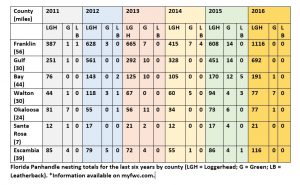 If you want to see a sea turtle in the Florida Panhandle, please visit one of the state-permitted captive sea turtle facilities listed below, admission fees may be charged. Please call the number listed for more information.
If you want to see a sea turtle in the Florida Panhandle, please visit one of the state-permitted captive sea turtle facilities listed below, admission fees may be charged. Please call the number listed for more information.
- Gulf Specimen Marine Laboratory, 222 Clark Dr, Panacea, FL 32346 850-984-5297 Admission Fee
- Gulf World Marine Park, 15412 Front Beach Rd, Panama City, FL 32413 850-234-5271 Admission Fee
- Gulfarium Marine Adventure Park, 1010 Miracle Strip Parkway SE, Fort Walton Beach, FL 32548 850-243-9046 or 800-247-8575 Admission Fee
- Navarre Beach Sea Turtle Center, 8740 Gulf Blvd, Navarre, FL 32566 850-499-6774
To watch a female loggerhead turtle nest on the beach, please join a permitted public turtle watch. During sea turtle nesting season, The Emerald Coast CVB/Okaloosa County Tourist Development Council offers Nighttime Educational Beach Walks. The walks are part of an effort to protect the sea turtle populations along the Emerald Coast, increase ecotourism in the area and provide additional family-friendly activities. For more information or to sign up, please email ECTurtleWatch@gmail.com. An event page may also be found on the Emerald Coast CVB’s Facebook page: facebook.com/FloridasEmeraldCoast.












